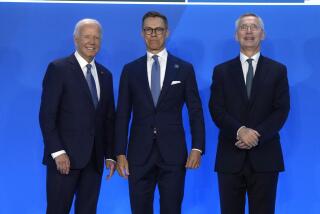New Pacts Break Logjam on Trade : NAFTA: Negotiators for the U.S., Canada and Mexico agree on sanctions, fines for breaking environmental, labor laws. Side deals may ease passage in Congress.
In a breakthrough that could clear the way for ratification of the North American Free Trade Agreement this fall, the United States, Mexico and Canada on Friday announced completion of contentious side pacts designed to preserve the environment and protect worker rights.
The supplementary agreements, negotiated in a round of late-night phone diplomacy, would establish fact-finding commissions and provide for trade sanctions or fines if any of the three countries fails to enforce its labor or environmental laws. They are designed to address reservations expressed by President Clinton and members of Congress about the trade accord.
“In all of trade history, this is the first agreement that ever really got any teeth in environmental standards, any teeth in what another country had to do with its own workers and its own labor standards,” Clinton told reporters after the agreements were announced. “There’s never been anything like this before. . . . I think it clearly will give the American people more jobs than it will cost. It’ll be a big job gainer for us, and it will be good for our economy.”
The side deals were announced only hours after U.S. and Mexican negotiators won Canada’s support by agreeing that Canada would be subject only to fines, not sanctions, if it is found to violate terms of the free trade agreement.
“With this historic event, we can reform a trade relationship with Mexico that has been driven more by accident than by design,” said U.S. Trade Representative Mickey Kantor. “NAFTA brings us a step closer to President Clinton’s goal of creating a high-wage, high-growth economy prepared for economic challenges as we enter the next century.”
The breakthrough was hailed by Mexican President Carlos Salinas de Gortari, who has promoted the agreement as the culmination of his efforts to reform Mexico’s economy. The three-nation trade pact “will bring Mexico more foreign investment and economic stability and provide a base for sustainable wage increases,” Salinas said in a nationally televised speech. “We also gained a lot of ways to cooperate on environmental and labor issues.”
To ensure that the trade pact contributes to the recovery of Mexican workers’ spending power, which has taken a beating over the last decade, Salinas said that he has proposed linking increases in the minimum wage to the average increase in national productivity. However, he did not say how the productivity increase would be measured.
The side agreements, announced simultaneously in Washington, Mexico City and Ottawa, represent a milestone in the effort to gradually eliminate barriers to free trade between the three countries. If ratified by lawmakers in all three nations, NAFTA would create the world’s largest free trade zone, with 370 million consumers and combined annual economic output of $6.5 trillion, Kantor said.
But key obstacles remain, such as the need to obtain an estimated $7 billion to $10 billion to finance a massive environmental cleanup along the U.S.-Mexican border. Kantor said that negotiators still are exploring the issue and plan further discussions in coming weeks.
Perhaps the biggest potential problems await on Capitol Hill, where many members of Congress fear that they stand to lose more than they might gain by voting for the pact. Administration officials have conceded that they face an uphill fight to secure ratification, and they will need to pick up support from Republicans who have opposed other Clinton initiatives.
In an interview Thursday, the President said that “nearly every trade agreement has been unpopular. . . . Very few of them that I know have had a slam-dunk in Congress.”
But he added: “What I hope to do with NAFTA . . . is to really let a reasoned debate unfold. . . . I would like to see the members of Congress who have not already committed one way or the other to just sort of hold their powder until they see this agreement, until they read its fine print, really have a chance to evaluate it.”
Recognizing that he would be unable to count on the support of substantial numbers of Democrats, he said: “The real question is whether we can pick up more Republicans than we’ll lose Democrats. That’s the bottom-line issue.”
NAFTA “is plainly going to be the most divisive” issue facing Congress in the next few months, Clinton said, acknowledging that he cannot depend on the solid support of his own party members, many of whom oppose the pact.
The President’s principal advisers remain divided on how to approach NAFTA--a division that began in the early days of Clinton’s presidential campaign and has never fully been resolved.
Ardent supporters of the treaty, including presidential counselor David Gergen, Treasury Secretary Lloyd Bentsen and other senior members of Clinton’s economic team, have argued that passage will spur economic growth and is crucial both to maintaining stable relations with Mexico and to Clinton’s stance as a “new Democrat” who can work with business leaders to revive the economy.
Others within the White House, including, according to Clinton advisers, First Lady Hillary Rodham Clinton, senior adviser George Stephanopoulos and Clinton’s outside political strategist James Carville, remain more skeptical. They have argued that an all-out push for the treaty could so alienate large numbers of Clinton’s supporters that it could undermine any hope of winning other crucial measures, including health care reform.
The skeptics point, for example, to a recent meeting in which AFL-CIO President Lane Kirkland told senior White House officials that the labor federation had budgeted several million dollars to spend over the next year on political activities. That money could be spent either to oppose the trade agreement or to support health care reform, but not both, Kirkland warned, according to Administration officials.
Many key lawmakers already are bracing for the fight. House Majority Leader Richard A. Gephardt (D-Mo.), a prominent critic of the accord, said that it seems to have solid support in the Senate but faces mixed prospects in the House. Gephardt and Sen. Max Baucus (D-Mont.), chairman of a key trade subcommittee, are pressing for tougher trade sanctions to accompany the agreement.
Environmental and labor groups, who fear that the agreement would undermine U.S. environmental protections and trigger a flight of jobs to Mexico, angrily denounced the side pacts and promised to launch a nationwide campaign to drum up voter opposition.
“If the teeth in this agreement were in a lion, he’d have to eat pablum,” William H. Bywater, president of the International Union of Electronic Workers, thundered in a Washington news conference. “This is not an agreement, it’s a sellout.”
Gephardt, a key voice in Congress on trade issues, said that he, too, would oppose the agreements. He complained that U.S. negotiators failed to make sufficient progress on enforcing the pact or funding the huge border cleanup.
“Although progress has been achieved, the announced side agreements fall short in important respects and taken alone are not supportable,” said Gephardt. “I am not optimistic that these deficiencies can be successfully resolved.”
But Rep. Robert T. Matsui (D-Sacramento), a longtime booster of the agreement, said that the side pacts now give the trade accord better odds in Congress than those facing the Clinton budget measure that won final approval last week.
“This is a lot different than the budget battle,” Matsui said. “The party is certainly not united. But these side agreements will help us move NAFTA along.”
The talks over the side agreements were launched by Clinton in an effort to tighten provisions in the pact on labor and the environment. The President had complained during his campaign for office that trade negotiators for former President George Bush had failed to nail down assurances from Mexico that it would toughen its environmental and labor laws to reduce the chance that U.S. companies would move to Mexico to take advantage of lax regulation there.
Clinton’s negotiators appeared to have stumbled Thursday when Canadian trade officials balked at suggestions that their country should be subject to sanctions if the independent commission determined that Canada had failed to comply with environmental and labor laws.
The United States and Mexico subsequently agreed that while they would remain liable to sanctions, they would not be imposed on Canada. Instead, they agreed to allow that country’s court system to impose fines recommended by a trilateral trade commission.
Each infraction would be subject to a maximum $20-million fine during the first year. But allegations of wrongdoing would have to meet stiff tests: The trilateral panel could act only upon finding “a persistent pattern of failure to effectively enforce” violations of labor or environmental laws.
Jeffrey J. Schott, a senior fellow at the Institute for International Economics in Washington, said that the contentious trade history between Canada and the United States was the source of the Canadian reluctance to agree to trade sanctions. But he said it is unlikely that many disputes will reach the stage where sanctions would become necessary.
“The publicity from reports generated by these commissions will be sufficient to generate action,” Schott said. “Sunshine is the best disinfectant.”
Mexican Commerce Minister Jaime Serra Puche called his country’s decision to accept sanctions rather than embracing the Canadian alternative of letting an international organization use Mexican courts to collect fines “a defense of national sovereignty.”
But economist Rogelio Ramirez de la O laughed at that characterization.
“Mexico accepted sanctions in their most outrageous form,” he said. Provisions that would virtually block Mexico’s trade with the United States because of environmental or labor complaints can easily be manipulated by protectionist interests, he said.
“That is exactly the reason the Canadians opposed them,” he said.
Times staff writers Juanita Darling in Mexico City, John M. Broder in Oakland and David Lauter in Washington contributed to this article.
* RELATED STORY: D1
Sealing the Trade Pact
Here is what’s at stake under the trade plan:
* Trade pact’s goal: To drop trade tariffs among the United States, Mexico and Canada, creating the world’s largest free trade zone.
* This week’s breakthrough: Agreement on environmental and labor issues that had delayed approval.
* The market: 370 million consumers
* Annual production: $6.5 trillion
* Next step: Clinton submits pact to Congress when it returns from its summer recess next month.
* Takes effect: Jan. 1, if ratified
* How Americans view it: Los Angeles Times Poll taken in June found respondents:
In favor: 22%
Opposed: 32%
Don’t know: 46%
Los Angeles Times Poll of 1,474 adults taken nationwide, June 12-14, 1993. Margin of error is plus or minus 3 percentage points.
DETAILS OF FRIDAY’S ANNOUNCEMENT
* On enforcing environmental and labor standards:
If a country fails to enforce environmental or labor standards, dispute would be sent to tri-national commissions. If the matter can’t be resolved there, the disagreement is forwarded to an arbitration panel of independent experts.
If the arbitration panel finds that either the United States or Mexico has persistently failed to enforce standards and doesn’t agree to changes, panel can impose trade sanctions in the form of tariffs or quotas. In the case of Canadian violations, the panel would go to Canadian courts seeking fines.
* On improving U.S.-Mexico border conditions:
United States and Mexico would work together to improve the environment and infrastructure along the polluted border region. The two countries also have agreed to provide financing for the border improvements but have yet to work out the details.
Source: Times staff and wire reports
More to Read
Sign up for Essential California
The most important California stories and recommendations in your inbox every morning.
You may occasionally receive promotional content from the Los Angeles Times.










